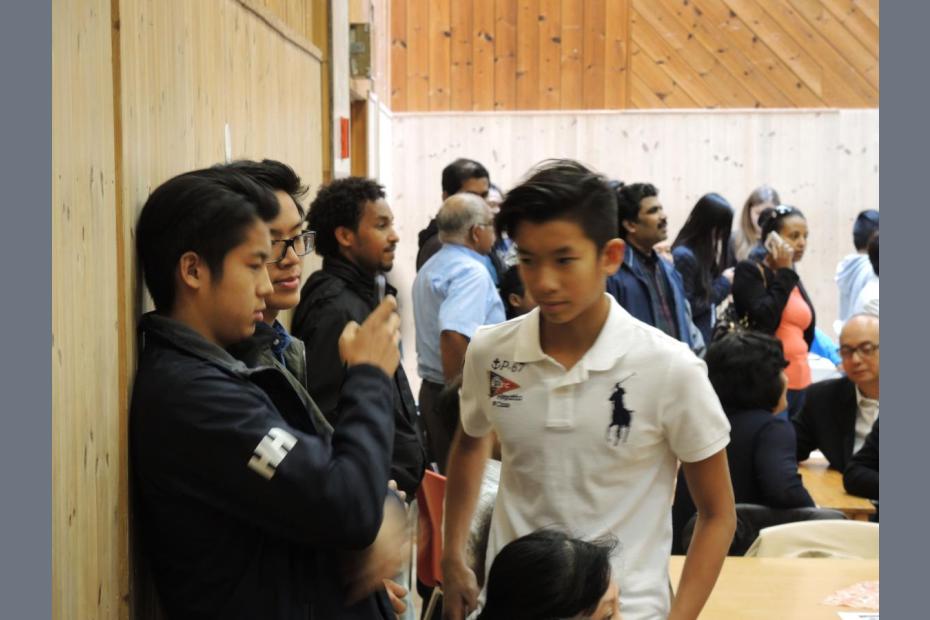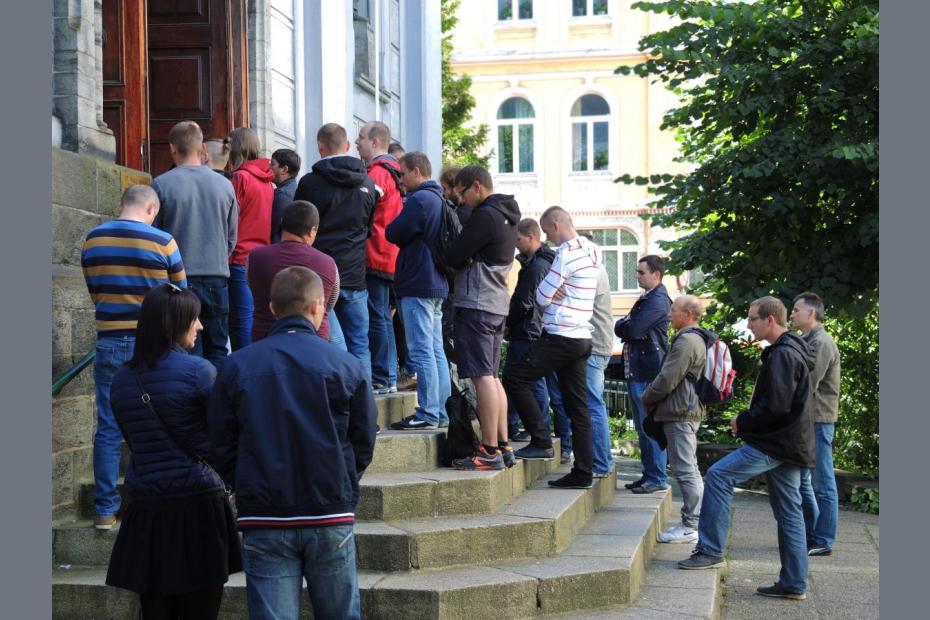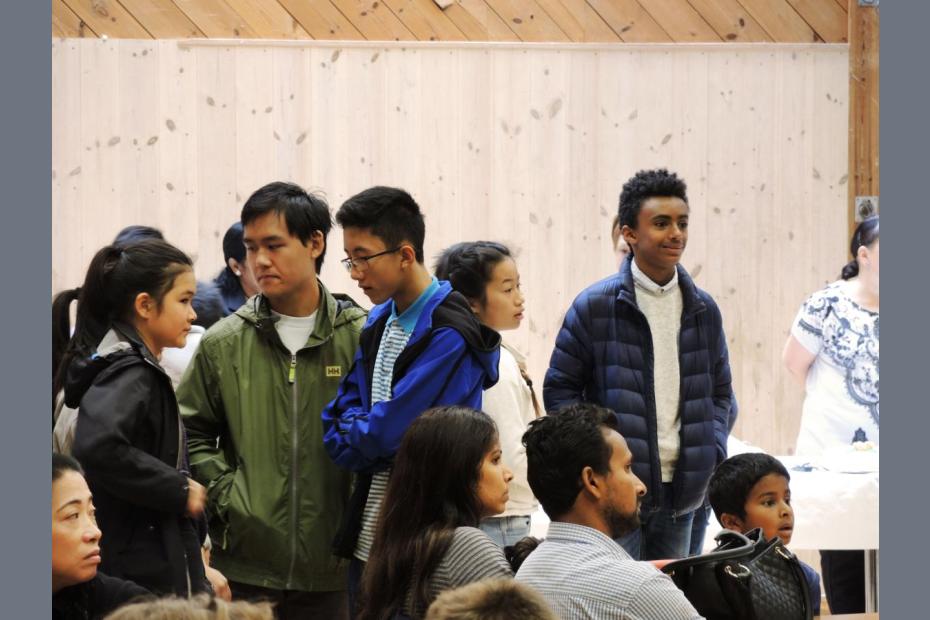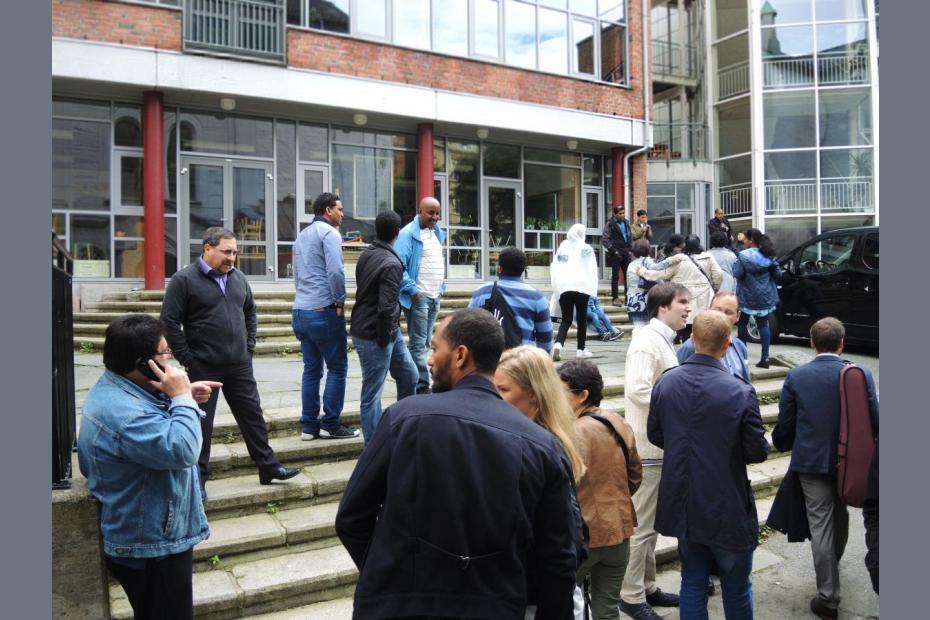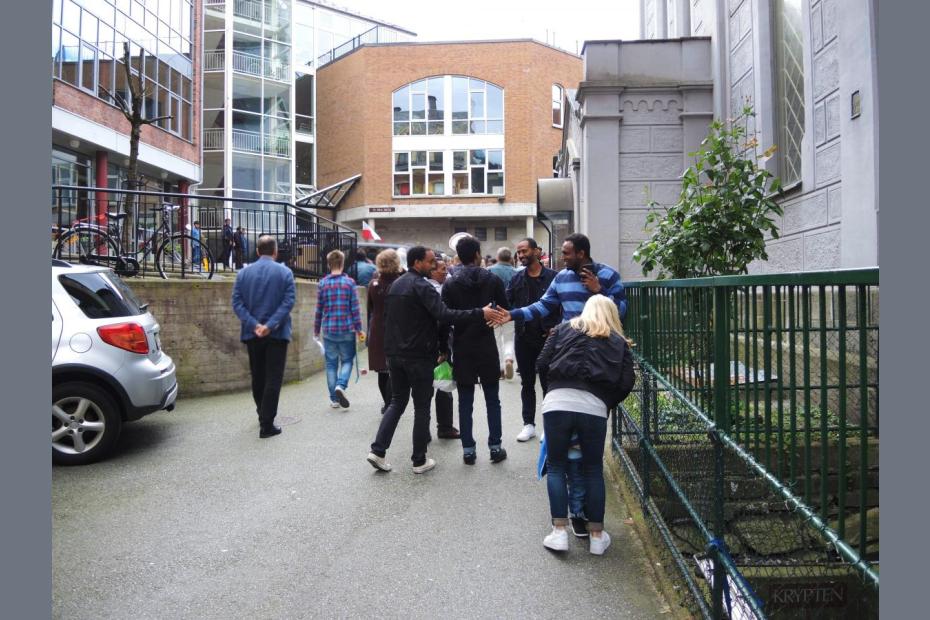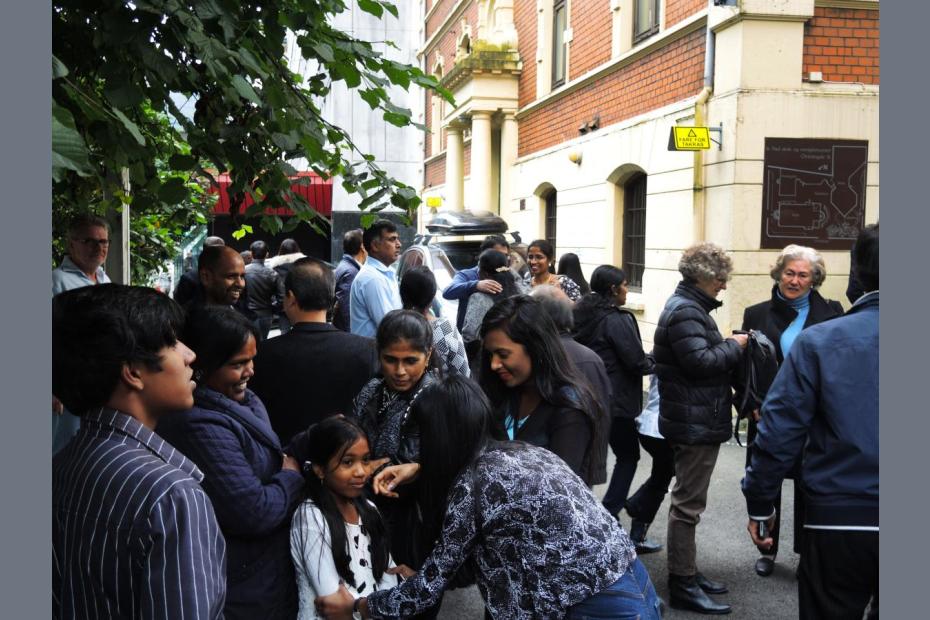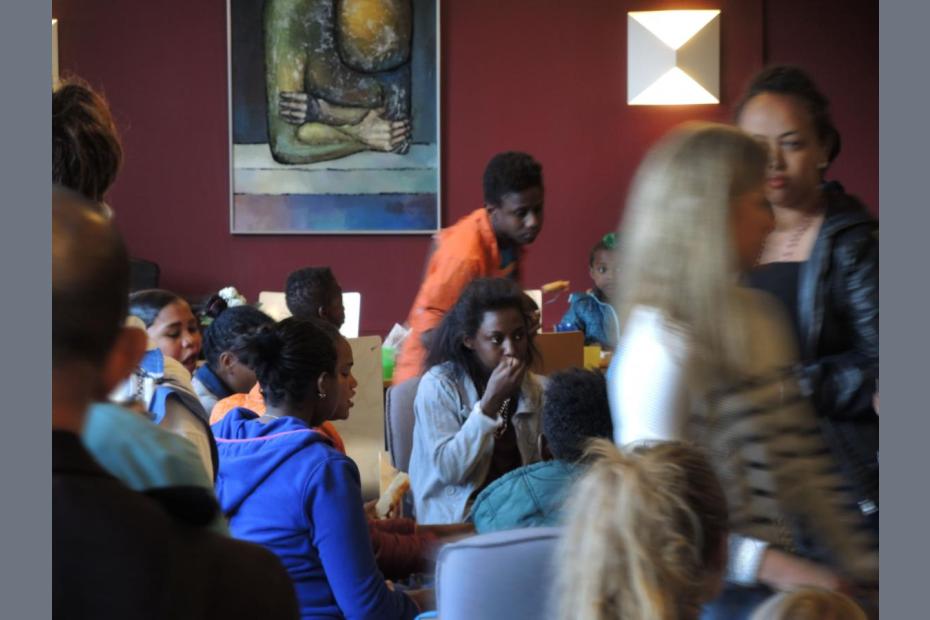Given that the story of the Catholic Church in Norway is so integrally a story of immigrants, a separate section on immigration might seem redundant, but there are some immigrant issues worth highlighting here, while others are covered in the section on family. One native-born Norwegian noted, without a trace of rancor, that in a church with so many immigrants, it’s a matter of figuring out not how to integrate the immigrants in the parish, but how to integrate the Norwegians. Norwegians even have their own affinity group within the parish, alongside the many national ones. Meeting space for national groups’ gatherings in the parish buildings is often at a premium, and some, like a Latin American group, have informal meetings in each other’s homes.
Until perhaps 30 years ago, the Norwegian Catholic Church was overwhelmingly Norwegian in outlook and composition, and very small. Older members talk about a church in the city of Bergen composed of about 500 people, mostly Norwegian families, very small and very tight. Some mention is made of Hungarian immigrants in the late 1950s, or of a small number of other migrants, but the first larger waves of immigrants came from Sri Lanka and Chile in the 1970s. The former were primarily students and the latter were mostly leftist political refugees whose attachment to the Church was often primarily cultural, though they came together around a Chilean priest who ministered to them at the time. Political refugee groups since then included Vietnamese, Tamil Sri Lankans, and Eritreans. Others have come primarily for economic reasons, including Filipinos, sub-Saharan Africans, Latin Americans and — since 2004 — large groups of Poles and Lithuanians who have grown that single parish in Bergen to about 17,500.
Broadly, immigrant interviewees were grateful to live in Norway, especially for the opportunities that the country provided their children.1 They talked about the country’s prosperity, modesty and egalitarianism as an unusual combination of traits. Compared to their home countries, many agreed that there is “more freedom here to do what you want,” though the implications of that were variously articulated as positive and negative. One Pole described it as the most respectful and polite society he has lived in, and compared to Poland described it as “a less fearful country, not having had so difficult a history.”
“You have to prove you are going to carry your weight, but once you do that, they trust you and things work well,” he said.
The migrants are not all in cities. Many are settled in relatively remote villages with few others from their country of origin, and the priests who minister to those ethnic groups travel a circuit to visit those families and celebrate Mass.
Assimilation — typically defined as understanding and respecting the cultural norms of the country, working to support one’s own family, and learning the Norwegian language — was a goal for all of the immigrant Catholics interviewed. All of them thought of themselves at best as “hyphenated Norwegians,” though as one noted, this is a complicated status.
“Norwegians don’t understand that you can have multiple [national] identities.”
For many interviewees, becoming Norwegian posed an additional particular challenge. In Bergen, the parish provided them space to continue to practice their faith, but as one person who was otherwise very settled in Norwegian life lamented, “To integrate into Norway is to not go to church.”
A number of observations surfaced in the course of interviews in Bergen, though it is hard to draw systematic conclusions across ethnicities about how migration to Norway affects all Catholics. Indeed, several communities reported experiences that contrasted with the experience of other communities. The following differences were observed among national groupings served by St. Paul’s parish in Bergen:
Poles
Polish migration has provided an opportunity and a challenge for the parish. With 6,986 registrants,2 it has doubled the size of the parish, which currently celebrates two of its seven weekend Masses in Polish. As the Polish community and the parish have grown, some have made moves to purchase an unused Church of Norway church for them to establish a Polish parish. Many parishioners, however, including some leading Poles, see this possibility as a huge threat to the identity of the very international parish they have built.
One Pole described the community as comprising three roughly equal sized groups. The first is largely integrating into Norwegian society, learns to speak Norwegian, participates in Norwegian and Polish social activities, and is interested to learn what they can from the Norwegian experience. The second group has some settled roots here, but other than at work, stays close to the local Polish community and the church. The third group, particularly men who come without their families, is here briefly and is eager to earn as much money as possible as quickly as possible before returning home. They spend free time Skyping, or video chatting, with family and friends at home, and not engaging outside the Polish community at all.
A Polish laywoman said that it is hopeless to organize the Poles in Bergen today, though they looked after themselves when they were still a small group. Now the priests have to organize many things. One Polish priest claimed, however, that it is easier to get young people involved in the Catholic Church in Norway than in Poland.
Perhaps the most significant change in the Norwegian context, one interviewee suggested, is that the even as Poles rely on the clergy to organize significant aspects of their collective religious life, Norwegian life is undermining the Poles’ willingness to accept their pastor’s words on authority alone. For Poles who are assimilating here in a pluralistic society, the clergy has to adjust to the idea that they have to “convince believers why” rather than than simply announce what the church teaches. The same thing is surely happening in some parts of Poland, but this interviewee saw this process happening even faster in Norway.
Lithuanians
Almost 2,300 Lithuanians are registered members of the parish, but these seem to be less visible as a group, and several active members of the parish guessed that Lithuanians constituted only 500 people in the parish. A Lithuanian-language Mass is celebrated in the parish one Sunday a month. Given political uncertainty with Russia, many are said to be eager to settle in Norway permanently. After the Russian incursions in Ukraine, large numbers have apparently resigned their citizenship in Lithuania. They come as families more than as single men and women. Those who knew the community said that there were probably about 5,000 Lithuanians in the Bergen area, suggesting that many had not registered as Catholics. One priest said that he was scared at how quickly they had become “Norwegian,” by which he meant absorbing Norwegian values and putting aside their Lithuanian identity. Some families are said to be confirming their children in the Church of Norway and availing themselves of the state church as needed.
Vietnamese
The Vietnamese (304 registrants born in Vietnam, but at least as many ethnic Vietnamese born in Norway) are said to be the most organized national group, electing their own leaders and running large events like Vietnamese New Year and Vietnamese Martyrs’ Day. They have a Vietnamese Mass one Sunday a month, and one weeknight Mass each week. A member of this community, born in Norway, was just ordained a priest, and a small group of Vietnamese nuns has moved to Bergen to begin work.
In contrast to other interviewees, the Vietnamese-born adults reported that they do not feel at all “Norwegian,” but were grateful to have found a place for themselves in Norway and especially appreciated the education that their children had received. Some struggled with how "Norwegian" their children had become, but nonetheless, perhaps by means of their tight communal organization, expected their children to carry on the faith. Whatever the cultural challenges in Norway, they were much more optimistic about their children’s ability to practice their faith in Norway than in Vietnam. In the parish they are well-known for making spring rolls in great quantities for school fundraisers and big social events. Still, some Vietnamese report, at events like Vietnamese Martyrs Day, they often had to adapt the celebrations for their Norwegian-born children, who preferred many Norwegian foods and activities.
Filipinos
The Filipino community, with 920 registrants, is primarily composed of women who had come to Norway to work as au pairs, nurses, health assistants and accountants, and stayed on to marry Norwegians. Not surprisingly, given Filipinos’ ebullience, openness and ease at reaching out to strangers, many found the culture of Norway to be difficult to adjust to. Several said that after many years, they still don’t know a number of their neighbors. In contrast to their home cultures, they also said that they like that Norwegians work hard, support their families, and are honest, and they asserted that Bergen is the safest place to live.
Many had husbands who are Church of Norway members, though some (reputedly more than any other ethnic group) had husbands who had become Catholic. In many matters at home, one woman whose husband is Protestant said, “Usually the Norwegian always wins.” “Always” and “usually,” though seemingly contradictory, are both important. Women told stories of how they do sometimes win out, but in each case that takes a lot of work on their part, at an emotional cost.
They worried that Norwegian culture would win when it came to their children’s faith, but also told stories of how they had tried hard to make sure this didn’t happen. Interviewees struggled most of all with how their children’s assimilation meant greater independence and greater risk of leaving the church once they were out of their mothers’ control. Some told of children who were involved as altar servers as youth, of having had to work hard to keep them in the faith, but watching them drift away in high school because their peers discouraged their practice.
“You cannot force kids here to do anything. In the Philippines, you would be pushed with family to go to church. But here, especially after they become 18, or after confirmation, they say, ‘I am free, you cannot force me.’ It is so different.”
Filipina interviewees suggested that the fact that they come from so many different local Filipino cultures has been a reason why they are not very united as a group in Bergen, but another reason seems to be the lack of space or permission to hold some of the feasts and devotions central to Filipino life. They carry Rosaries and medals, etc., but feel that they can’t show them in public. Having a Filipino priest has helped them come together in a way they hadn’t on their own, and connected them better to Filipino rituals and feasts and devotions. Now they celebrate Sinulog, the feast of the Santo Niño in January, and Flores de Mayo in May. They dance and bring food, which has helped them connect to the religious world that formed them.
Latin Americans
Latin Americans comprise 1,448 registrants at St. Paul parish, 840 of whom are Chilean. The rest come from many countries and cultures. A group that includes Chileans, Mexicans, Peruvians, Dominicans and Bolivians meets on Tuesdays, in various members’ homes. It tends to be an older group of participants. They pray the Rosary from 6:30-7, then have coffee and cakes at 7:30, and have time to talk about their faith and their ordinary concerns. Overall, though, many Latin Americans, particularly Chileans, were said to be primarily present for baptism, marriage and burial.
The experience of one member of this group bears witness to a significant change to her Catholic imagination as a result of having lived in Norway. A Mexican interviewee said that she had reconfigured her relationship to suffering and pain in terms of religiosity. She said that her inherited focus on suffering, when it came to Jesus, Mary and the saints, had made her “fall into self pity, and I don’t like it. I don’t want that back again. I get too focused on my sufferings and my problems. It’s a common thing in my culture. We Latins have that sense of self-pity.”
In Norway, she grew to believe that if she had a problem, she needed to work to fix it, “not just feel bad about it.” “The focus in the images here is on the good things. People here work and try to solve problems.”
For a variety of reasons, lay members of a number of communities, including Eritreans and Tamils, were not interviewed.
How does immigration affect Norwegian Catholics?
Most interviewees indicated that Norwegian Catholics are much more cerebral (or perhaps, though they did not use the term, “disenchanted,” as sociologist and philosopher Max Weber would describe it)3 in their faith, and much less prone to the forms of devotion that sustain many immigrant Catholics. Many Norwegian converts, particularly those attached to a romantic, nationalist Catholic narrative, have trouble coming to terms with immigrants’ devotional practices, but it is certainly true that the immigrants have brought extraordinary vitality that has remade the parish.
Immigrants sometimes framed the same difference as a matter of Norwegian parishioners not being “as Catholic” as them, not “getting” the fullness of Catholic forms of devotion and spirituality. One Norwegian convert volunteered that she found the critique to be true, and that she was coming to better understand Catholicism as a lived spirituality, and coming to value some of the daily habits that integrated faith in immigrants’ lives, such as habits of “offering up” suffering and seeing God consistently at work in the world.
Like many northern European countries, Norway is in the midst of a significant political debate about whether it absorbs as many migrants as are moving there, especially in light of mass migration from the Syrian conflict. Almost all interviewees suggested that Catholics were fairly liberal on this question, conscious of their families’ status as migrants and of the stories of migrants in their parish.
- 1The articles presented here are based primarily on interviews conducted in September 2015 in Bergen with 20 Catholics and one member of the Church of Norway. Interviewees were evenly split between men and women. Fourteen were immigrants, and six were native Norwegians. Briefer conversations with several parish priests helped supplement the information here. Most Catholic interviewees were very active in the parish.
- 2Data on numbers includes those officially registered with St. Paul’s parish and the government as of June 2015. They are organized by the place of birth of the registrant, such that the Norwegian-born child of a Pole is officially counted as Norwegian, not Polish, for these purposes.
- 3For Max Weber, the term describes a defining trait of modernity, a world where, even among religious believers, a mysterious, spirit-filled world has been displaced and replaced by a more rational ‘scientific’ perspective. See Max Weber, “Science as a Vocation,” in H.H. Gerth and C. Wright Mills, eds., From Max Weber: Essays in Sociology, 129-156, and The Protestant Ethic and the Spirit of Capitalism, trans. Talcott Parsons, London and New York: Routledge, 2001.
